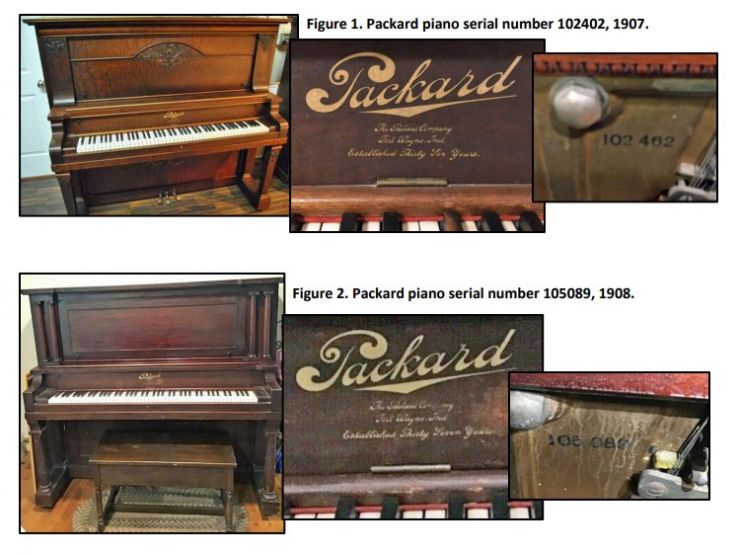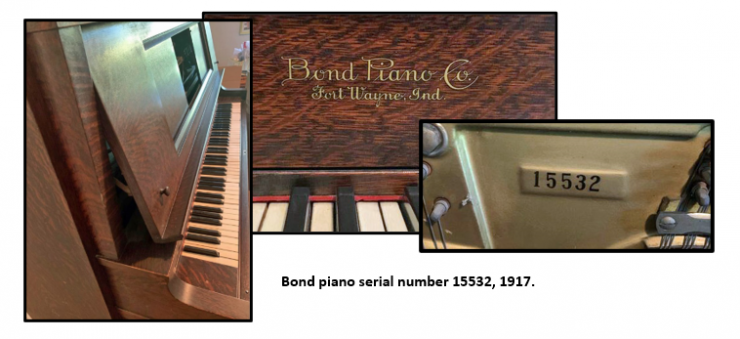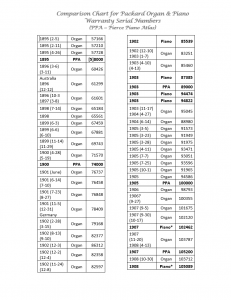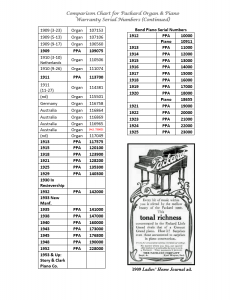Packard Piano Serial Numbers Compared to Organ Warranty Numbers
When the Fort Wayne Organ Company began to manufacture organs in 1872, they used
two sets of serial numbers: one for the actions to be installed in various cases, and a warranty
serial number assigned to the instrument once it was ready to leave the factory. Because Isaac
Packard considered the manufacturing of the Packard organ to be a continuation of his many years
in the business, the initial warranty serial number began at around 7100. This was for the purpose
of showing to the public that they had been in business for some years. For in-house purposes, the
action serial numbers began with number one.
This spread of around 7000 between the two serial numbers was maintained until the early
1880s, when it appeared that the company was experimenting with a different in-house set of
serial numbers for actions with no discernable pattern. The warranty serial numbers appeared to
continue in sequential order. By 1888, the two numbers had slipped back into a more consistent
lock-step separation, but this time the difference was in the 20,000+ range where it remained until
the introduction of the Packard piano. The question that was floating around in my mind: “Was
there a connection between the organ and piano serial numbers?”
As my focus had been on the organ side of production, I had not paid much attention to
the piano materials I had incidentally collected while looking for organ literature. I had
accumulated a sizable amount, and, once the first volume was at the printers, I began to seriously
consider that the piano material might be worthy of a second volume. I still had a question in my
mind about why the spread was growing in the serial numbers in the organ database.
In internet searches, I found a series of references to Packard piano serial numbers, in
particular the Pierce Piano Atlas, which had been published for many years. I also found two
Packard pianos for sale that had information that became vital in my search for answers. Each
posted a photo of its serial number along with a closeup of the stopboard name. Surprisingly,
besides the usual information, they included a line which said, “Established Thirty Six Years”
(Fig. 1), and on the second one, “Established Thirty Seven Years” (Fig. 2). Knowing the company used
the year 1871 as its starting point, I concluded that if they only used each label during the year it
was manufactured, it would mean one was dated 1907, and the second one 1908.
I took the two numbers and compared them with my organ warranty serial numbers and
was surprised to see that they were a match! I then took the serial numbers listed in the Pierce
Piano Atlas and compared their set of numbers with my database. They also were an excellent
match! The lone exception was the year Packard introduced their piano in 1895; Pierce Piano Atlas
used a number of 68,000 to began the piano serial number sequence. However, in looking at the
organ data and using the number 58,000, it became a perfect fit into the organ warranty
sequence. For that reason, I believe that this initial listing in the atlas was in error and have so
noted it as such in the chart which follows.
On my comparison chart, I have reduced the data from my original organ date chart (2) to
only include serial numbers which had specific dates beginning in 1895. You’ll notice that some of
the dates have two months. This is due to the fact some organs went through more than one
tuning before leaving the factory, especially large instruments. The intermingled piano serial
numbers are in bold lettering.
You will notice towards the end of the chart that there are seven organ serial number
entries without a date. When the company announced that they would cease production in mid-
1912, (3) they had indicated that they would continue to fill orders already in the pipeline. The fact that five of the seven numbers are from overseas countries would tend to prove this out as it
would take longer to settle accounts with overseas dealers than it would domestic dealers.
(1) Charles A. Robison, The Fort Wayne Organ Company & the Packard Legacy: Volume 1 (Independence, MO, 2020) 288.
(2) Robison, Packard Legacy: Vol. 1, 290-307.
(3) “NEW $100,000 BOND PIANO CO.; THE PACKARD ORGAN SILENT,” Fort Wayne Journal-Gazette, June 13, 1912, 1. Production and Serial Numbers





